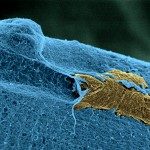Lien vers Pubmed [PMID] – 25599466
Crit. Care Med. 2015 Feb;43(2):422-9
OBJECTIVES: The availability of circulating biomarkers that helps to identify early out-of-hospital cardiac arrest survivors who are at increased risk of long-term mortality remains challenging. Our aim was to prospectively study the association between copeptin and 1-year mortality in patients with out-of-hospital cardiac arrest admitted in a tertiary cardiac arrest center.
DESIGN: Retrospective monocenter study.
SETTING: Tertiary cardiac arrest center in Paris, France.
PATIENTS: Copeptin was assessed at admission and day 3. Pre- and intrahospital factors associated with 1-year mortality were analyzed by multivariate Cox proportional analysis.
INTERVENTIONS: None.
MEASUREMENTS AND MAIN RESULTS: Two hundred ninety-eight consecutive out-of-hospital cardiac arrest patients (70.3% male; median age, 60.2 yr [49.9-71.4]) were admitted in a tertiary cardiac arrest center in Paris (France). After multivariate analysis, higher admission copeptin was associated with 1-year mortality with a threshold effect (hazard ratio(5th vs 1st quintile) = 1.64; 95% CI, 1.05-2.58; p = 0.03). Day 3 copeptin was associated with 1-year mortality in a dose-dependent manner (hazard ratio(2nd vs 1st quintile) = 1.87; 95% CI, 1.00-3.49; p = 0.05; hazard ratio(3rd vs 1st quintile) = 1.92; 95% CI, 1.02-3.64; p = 0.04; hazard ratio(4th vs 1st quintile) = 2.12; 95% CI, 1.14-3.93; p = 0.02; and hazard ratio(5th vs 1st quintile) = 2.75; 95% CI, 1.47-5.15; p < 0.01; p for trend < 0.01). For both admission and day 3 copeptin, association with 1-year mortality existed for out-of-hospital cardiac arrest of cardiac origin only (p for interaction = 0.05 and < 0.01, respectively). When admission and day 3 copeptin were mutually adjusted, only day 3 copeptin remained associated with 1-year mortality in a dose-dependent manner (p for trend = 0.01).
CONCLUSION: High levels of copeptin were associated with 1-year mortality independently from prehospital and intrahospital risk factors, especially in out-of-hospital cardiac arrest of cardiac origin. Day 3 copeptin was superior to admission copeptin: this could permit identification of out-of-hospital cardiac arrest survivors at increased risk of mortality and allow for close observation of such patients.
